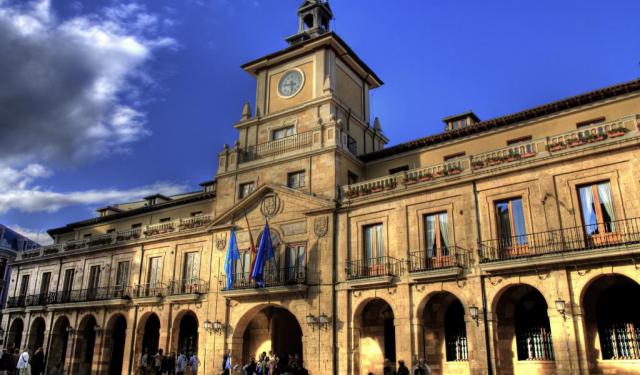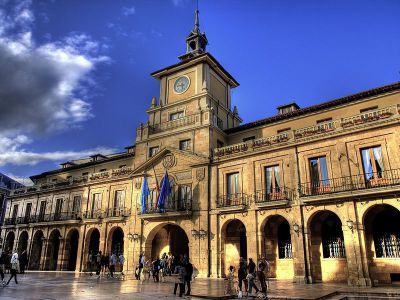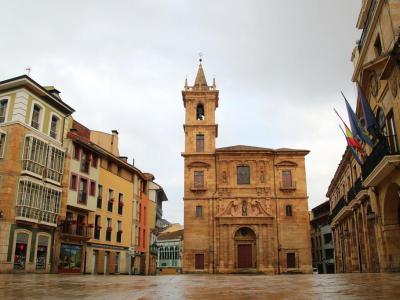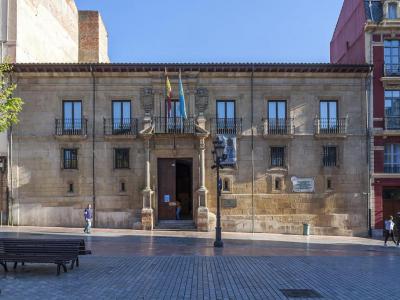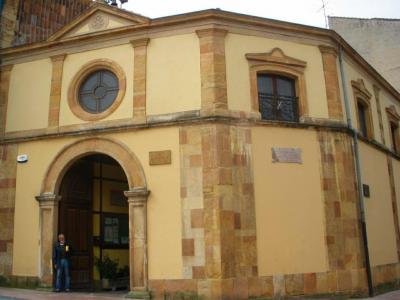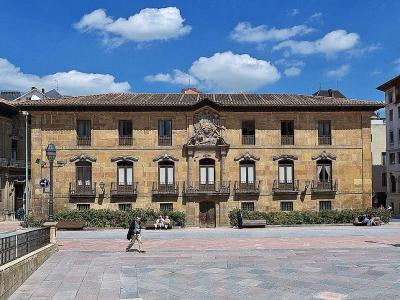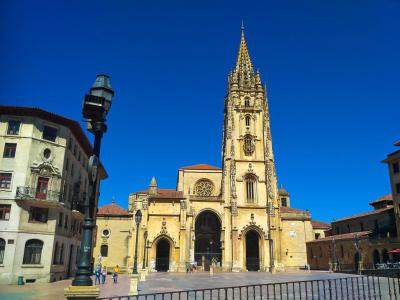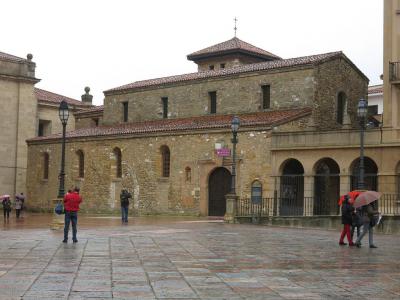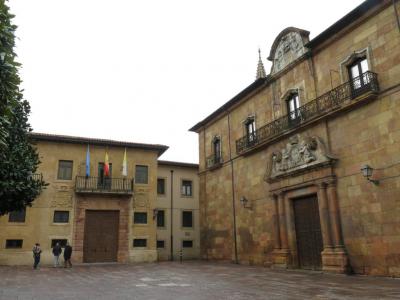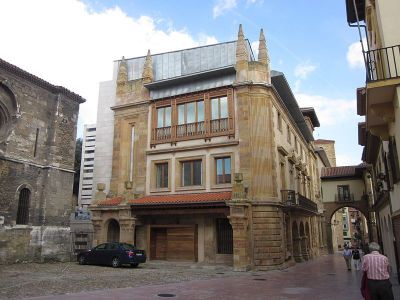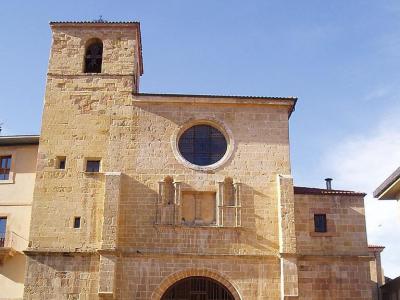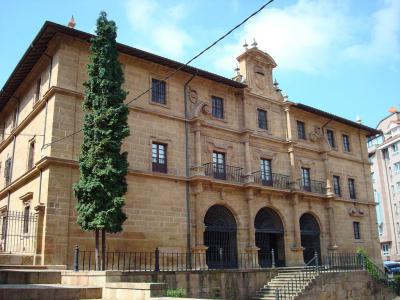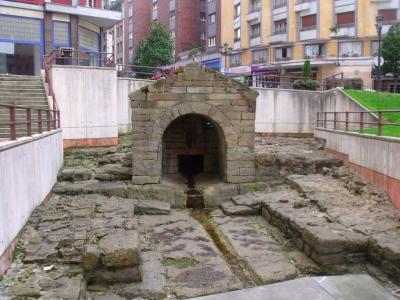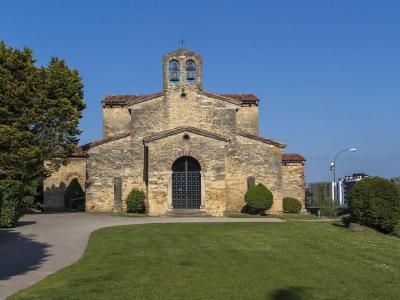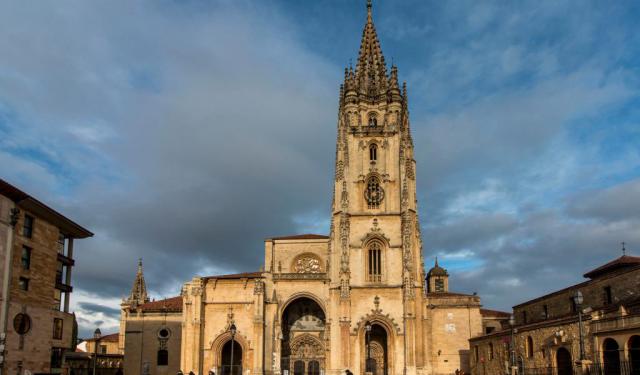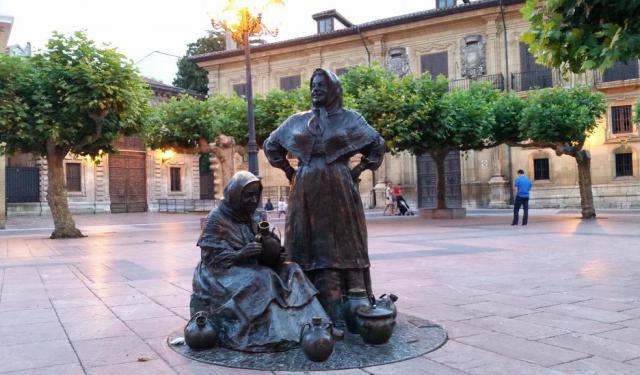Oviedo Historic Architecture (Self Guided), Oviedo
The north Spanish region of Asturias and particularly its capital city, Oviedo, have long been noted for their unique architecture. The medieval part of town, whose ancient walls are still largely intact, contains some truly priceless relics. Among them is a well called La Foncalada, a fascinating example of an effective hydraulic system, dating back to the first half of the 9th century, based on an even older, Roman technology.
During the 9th century, the then small kingdom, Asturias gave rise to an innovative Pre-Romanesque architectural style that was to play a significant role in the development of religious architecture throughout the Iberian peninsula. Indeed, the majority of notable historic buildings here are religious ones, such as the Church of San Tirso and the San Julian de los Prados Basilica, popularly known as “Santullano”, constructed from 791-842. The later temples, like the Gothic San Salvador Cathedral from the 15th century, serve as an illustration of how Christianity has persisted in northern Spain ever since that early period.
Among other representative examples is The Archaeological Museum of Asturias, located in the 16th-century cloister of the Benedictine monastery of Saint Vicente, the San Pelayo Convent, and other religious and secular locations.
The cultural heritage and layout of Oviedo still faithfully reflect its original urban plan. Some of the local architectural monuments have been around for so long that they bore witness to Oviedo’s heyday during the Middle Ages. If you wish to see the most prominent of them and appreciate the town in its entirety, take this self-guided walking tour.
During the 9th century, the then small kingdom, Asturias gave rise to an innovative Pre-Romanesque architectural style that was to play a significant role in the development of religious architecture throughout the Iberian peninsula. Indeed, the majority of notable historic buildings here are religious ones, such as the Church of San Tirso and the San Julian de los Prados Basilica, popularly known as “Santullano”, constructed from 791-842. The later temples, like the Gothic San Salvador Cathedral from the 15th century, serve as an illustration of how Christianity has persisted in northern Spain ever since that early period.
Among other representative examples is The Archaeological Museum of Asturias, located in the 16th-century cloister of the Benedictine monastery of Saint Vicente, the San Pelayo Convent, and other religious and secular locations.
The cultural heritage and layout of Oviedo still faithfully reflect its original urban plan. Some of the local architectural monuments have been around for so long that they bore witness to Oviedo’s heyday during the Middle Ages. If you wish to see the most prominent of them and appreciate the town in its entirety, take this self-guided walking tour.
How it works: Download the app "GPSmyCity: Walks in 1K+ Cities" from Apple App Store or Google Play Store to your mobile phone or tablet. The app turns your mobile device into a personal tour guide and its built-in GPS navigation functions guide you from one tour stop to next. The app works offline, so no data plan is needed when traveling abroad.
Oviedo Historic Architecture Map
Guide Name: Oviedo Historic Architecture
Guide Location: Spain » Oviedo (See other walking tours in Oviedo)
Guide Type: Self-guided Walking Tour (Sightseeing)
# of Attractions: 13
Tour Duration: 2 Hour(s)
Travel Distance: 2.7 Km or 1.7 Miles
Author: DanaOffice
Sight(s) Featured in This Guide:
Guide Location: Spain » Oviedo (See other walking tours in Oviedo)
Guide Type: Self-guided Walking Tour (Sightseeing)
# of Attractions: 13
Tour Duration: 2 Hour(s)
Travel Distance: 2.7 Km or 1.7 Miles
Author: DanaOffice
Sight(s) Featured in This Guide:
- Casa Consistorial de Oviedo (Oviedo Town Hall )
- Iglesia de San Isidoro (San Isidoro Church)
- Palacio de los Condes de Toreno (Palace of the Counts of Toreno)
- Capilla de la Balesquida (Balesquida Chapel)
- Palacio de Valdecarzana-Heredia (Valdecarzana-Heredia Palace)
- Cathedral of San Salvador
- Iglesia de San Tirso (Church of Saint Thyrsus)
- Corrada del Obispo (Bishop's Run Square)
- Archaeological Museum of Asturias
- Monasterio de San Vicente (San Vicente Monastery)
- Monasterio de San Pelayo (San Pelayo Convent)
- Fuente de Foncalada (Foncalada Fountain)
- San Julián de los Prados Church
1) Casa Consistorial de Oviedo (Oviedo Town Hall )
The town administration of Oviedo, formed shortly after the creation of Oviedo municipality (by the royal decree of Fuero de Oviedo) in the mid 12th century, originally met inside the Church of San Tirso. As the importance of the municipality grew, the authorities sought to have a designated building that would serve their needs. Pursuant to this objective, in 1622, they commissioned architect Juan de Naveda to design a town hall.
The current building was constructed on the remains of the ancient city walls and the Puerta de Cimadevilla (Cimadevilla Gate). The latter now acts as a passage underneath the Town Hall's central clock tower. In 1671, the construction was finished. In 1780, the Town Hall underwent its first extensive renovation, carried out by Francisco Pruneda.
During the Spanish Civil War, in the 1930s, the building suffered serious damage amid a widespread destruction of the entire neighborhoods of Uviéu, during which time the municipal government moved out into the Palace of the Duque del Parque. After the war, in 1940, the Town Hall was rebuilt by architect Gabriel de la Torriente, who, among other elements, added the clock tower.
Presently, the Town Hall represents a beautiful gallery comprising 13 arches, decorated with moldings and pilasters, and is included in the list of Oviedo's architectural heritage.
The current building was constructed on the remains of the ancient city walls and the Puerta de Cimadevilla (Cimadevilla Gate). The latter now acts as a passage underneath the Town Hall's central clock tower. In 1671, the construction was finished. In 1780, the Town Hall underwent its first extensive renovation, carried out by Francisco Pruneda.
During the Spanish Civil War, in the 1930s, the building suffered serious damage amid a widespread destruction of the entire neighborhoods of Uviéu, during which time the municipal government moved out into the Palace of the Duque del Parque. After the war, in 1940, the Town Hall was rebuilt by architect Gabriel de la Torriente, who, among other elements, added the clock tower.
Presently, the Town Hall represents a beautiful gallery comprising 13 arches, decorated with moldings and pilasters, and is included in the list of Oviedo's architectural heritage.
2) Iglesia de San Isidoro (San Isidoro Church)
The San Isidoro Church is a distinguished Baroque church dating to the 16th–17th century. Built between the late 1500s and its consecration in 1681, the structure replaced an earlier Romanesque chapel and was originally part of the Jesuit San Matías College.
From the outside, the church presents a gracious façade of warm-hued stone accented by a single bell tower-an asymmetry that hints at an ambitious twin-tower design that was never realized due to budget constraints. The portal is framed with slender columns and crowned with sculptural detailing.
Step inside and you’ll find a beautifully designed interior in a Latin-cross layout, featuring a single nave divided into four bays with interconnected side chapels, a transept capped by a dome, and a square sanctuary flanked by sacristies. Rich Baroque altarpieces decorate the side chapels, while the main altar gleams with gilt detail and refined wood carving.
Although smaller in scale than major cathedrals, the church offers an intimate yet awe-inspiring space; the vaulted ceilings, pilasters, and natural light streaming through upper windows create an ambiance of contemplative beauty. Frequent maintenance and restoration, ongoing since 1991, ensure visitors can enjoy its design and artworks in excellent condition.
From the outside, the church presents a gracious façade of warm-hued stone accented by a single bell tower-an asymmetry that hints at an ambitious twin-tower design that was never realized due to budget constraints. The portal is framed with slender columns and crowned with sculptural detailing.
Step inside and you’ll find a beautifully designed interior in a Latin-cross layout, featuring a single nave divided into four bays with interconnected side chapels, a transept capped by a dome, and a square sanctuary flanked by sacristies. Rich Baroque altarpieces decorate the side chapels, while the main altar gleams with gilt detail and refined wood carving.
Although smaller in scale than major cathedrals, the church offers an intimate yet awe-inspiring space; the vaulted ceilings, pilasters, and natural light streaming through upper windows create an ambiance of contemplative beauty. Frequent maintenance and restoration, ongoing since 1991, ensure visitors can enjoy its design and artworks in excellent condition.
3) Palacio de los Condes de Toreno (Palace of the Counts of Toreno)
The Palace of the Counts of Toreno is a Historic-Artistic Monument and one of the main examples of Baroque-style architecture in Oviedo.
This palace was built between 1673 and 1675 to a design by architect Gregorio de la Roza, who was commissioned to the job by the Malleza Doriga family. In 1786, José María Queipo de Llano y Ruiz de Saravia, 7th Count of Toreno and the former Prime Minister of Spain (in 1835), was born here.
The most distinctive features of this building are the asymmetrical, ashlar facade and the portal with columns and blazons arranged on each side of the central balcony, with openings in the form of arrow slits. Inside, there is a patio with Tuscan columns, as well as a monumental stone staircase on the right.
From 1958 to 1987, the palace housed the headquarters of the Provincial Public Library (together with the Library Coordination Center and the Provincial Historical Archive). Currently, it houses the headquarters of the Royal Institute of Asturian Studies.
This palace was built between 1673 and 1675 to a design by architect Gregorio de la Roza, who was commissioned to the job by the Malleza Doriga family. In 1786, José María Queipo de Llano y Ruiz de Saravia, 7th Count of Toreno and the former Prime Minister of Spain (in 1835), was born here.
The most distinctive features of this building are the asymmetrical, ashlar facade and the portal with columns and blazons arranged on each side of the central balcony, with openings in the form of arrow slits. Inside, there is a patio with Tuscan columns, as well as a monumental stone staircase on the right.
From 1958 to 1987, the palace housed the headquarters of the Provincial Public Library (together with the Library Coordination Center and the Provincial Historical Archive). Currently, it houses the headquarters of the Royal Institute of Asturian Studies.
4) Capilla de la Balesquida (Balesquida Chapel)
The Balesquida Chapel is a charming urban chapel steeped in history. Though modest in size, its story stretches back centuries-it was originally founded in 1232 by Doña Velasquita Giráldez, a noblewoman widely revered in Oviedo as “Lady Balesquida” for her generous donations that included a hospital for pilgrims and support for local citizens. The chapel derives its name from both her and the Tailors’ Brotherhood she supported.
The present Baroque-style structure dates from 1725, with major reconstructions in 1876 and 1952. Its exterior is unassuming but elegant, featuring a pale yellow façade accented by warm stone trim and a pair of scissors symbol carved into the corner balcony-a nod to its long association with the tailors’ guild. Accessible through a small paved atrium and arched doorway, the chapel’s entrance invites passersby to step into a peaceful sacred space.
Inside, the chapel houses three richly decorated altarpieces from the 17th and 18th centuries. The central altar displays a wooden statue of the Virgin of Hope-a Gothic-style image from the 18th century adorned with votive garments donated by devotees, and crowned by a relief of the Holy Spirit. Side altars honor Saint Jude Thaddeus and Saint Bernard of Clairvaux, each framed by intricately carved columns and polychrome wood sculpture.
Also inside are two dramatic paintings by Oviedo-born artist Francisco Reiter, depicting key events in the life of Saint Bernard: his appointment as Abbot of Clairvaux, and the Virgin Mary alongside saints interceding on his behalf. A Gothic-era sculpture of the Virgin and Child, dating to the 13th century, is prominently displayed within the presbytery-one of the oldest artworks preserved in the chapel.
The present Baroque-style structure dates from 1725, with major reconstructions in 1876 and 1952. Its exterior is unassuming but elegant, featuring a pale yellow façade accented by warm stone trim and a pair of scissors symbol carved into the corner balcony-a nod to its long association with the tailors’ guild. Accessible through a small paved atrium and arched doorway, the chapel’s entrance invites passersby to step into a peaceful sacred space.
Inside, the chapel houses three richly decorated altarpieces from the 17th and 18th centuries. The central altar displays a wooden statue of the Virgin of Hope-a Gothic-style image from the 18th century adorned with votive garments donated by devotees, and crowned by a relief of the Holy Spirit. Side altars honor Saint Jude Thaddeus and Saint Bernard of Clairvaux, each framed by intricately carved columns and polychrome wood sculpture.
Also inside are two dramatic paintings by Oviedo-born artist Francisco Reiter, depicting key events in the life of Saint Bernard: his appointment as Abbot of Clairvaux, and the Virgin Mary alongside saints interceding on his behalf. A Gothic-era sculpture of the Virgin and Child, dating to the 13th century, is prominently displayed within the presbytery-one of the oldest artworks preserved in the chapel.
5) Palacio de Valdecarzana-Heredia (Valdecarzana-Heredia Palace)
The Valdecarzana-Heredia palace, a large palatial complex in Plaza de la Catedral, was built between 1627 and 1629 by Don Diego de Miranda. It was designed as the seat for the Miranda family, one of the greatest lineages in the Principality of Asturias. As such, the palace occupies a privileged location, near the Cathedral, attesting to the family's dignified social status and economic and political power.
The house is a pure example of Baroque style. It follows the model of free-standing palaces with a cubic floor plan structured around a large central patio. The three-storey structure is very sober in appearance and consists of simple lines, creating a firm impression of stability.
Its bare western façade, of solid stonework, was once flanked by two four-storey towers, of which only one remains today. Here, you can see the Miranda family coat of arms with the crown of the Marquis of Valdecarzana. The eastern façade of the palace also features elaborate stonework and has, on its second floor, the coat of arms of the Miranda and Ponce de León. The second floor windows are accentuated with wrought iron balconies.
At the end of the 18th century, the Heredia family, the new owners of the palace, reformed the property, endowing its courtyard with the current southern façade, and demolishing the tower on that side along with the garden. Here, over the entrance, you can see the Heredia coat of arms, featuring Hercules fighting the Nemean lion, along with a figurehead featuring the inscription in the form of a diadem, dated 1774.
The seven balconies that open onto the main patio have a lowered arch and present artistic and molded finishes, with scallops and masks.
The house is a pure example of Baroque style. It follows the model of free-standing palaces with a cubic floor plan structured around a large central patio. The three-storey structure is very sober in appearance and consists of simple lines, creating a firm impression of stability.
Its bare western façade, of solid stonework, was once flanked by two four-storey towers, of which only one remains today. Here, you can see the Miranda family coat of arms with the crown of the Marquis of Valdecarzana. The eastern façade of the palace also features elaborate stonework and has, on its second floor, the coat of arms of the Miranda and Ponce de León. The second floor windows are accentuated with wrought iron balconies.
At the end of the 18th century, the Heredia family, the new owners of the palace, reformed the property, endowing its courtyard with the current southern façade, and demolishing the tower on that side along with the garden. Here, over the entrance, you can see the Heredia coat of arms, featuring Hercules fighting the Nemean lion, along with a figurehead featuring the inscription in the form of a diadem, dated 1774.
The seven balconies that open onto the main patio have a lowered arch and present artistic and molded finishes, with scallops and masks.
6) Cathedral of San Salvador (must see)
Alfonso II, king of Asturias, discovered the supposed tomb of Saint James the Greater in the town of Compostela in the eighth century. During his reign, Alfonso II built the Holy Chamber, Alfonso's chapel, and the treasury for the Cathedral of San Salvador in Oviedo, Asturias region of northern Spain.
The Cathedral of San Salvador, also known as the Metropolitan Cathedral Basilica of the Holy Saviour, is a Roman Catholic Church and a basilica in the center of Oviedo. Today, it features many architectural styles, from Pre-Romanesque to Baroque, including Romanesque, Gothic, and Renaissance elements.
The Holy Chamber is a two-story pre-Romanesque structure built on a rectangular plan. It serves as the treasury of the new cathedral of San Salvador. Royal burials are on the ground floor. The upper floor holds a collection of relics and royal treasures.
The aisle of the upper floor of the Chamber has twelve Romanesque columns depicting the apostles. The columns support the barrel vault roof. The Romanesque Old Tower belfry is raised by the addition of an arched gallery with a ribbed vault. There is evidence of a Romanesque cloister, replaced by the Gothic cloister of today.
In the late Middle Ages, the Oviedo Cathedral underwent so many changes that it became a new cathedral complex. Pre-Romanesque basilica and its environs were replaced. Gothic elements prevailed in the chapter room, cloister, master chapel, aisles, facade, and tower.
The church has three naves and side chapels, a transept, and a Renaissance ambulatory. The cathedral roof is supported by tall columns decorated with plant motifs. The altarpiece tells the story of Christ in Flemish-Gothic style pictures. The chapel of King Casto holds a pantheon for deceased Asturian royalty.
There is an old saying in Asturia: "Whoever goes to Santiago and not to the Savior, visits the servant and leaves the master." The master, of course, is the Cathedral of San Salvador.
The Cathedral of San Salvador, also known as the Metropolitan Cathedral Basilica of the Holy Saviour, is a Roman Catholic Church and a basilica in the center of Oviedo. Today, it features many architectural styles, from Pre-Romanesque to Baroque, including Romanesque, Gothic, and Renaissance elements.
The Holy Chamber is a two-story pre-Romanesque structure built on a rectangular plan. It serves as the treasury of the new cathedral of San Salvador. Royal burials are on the ground floor. The upper floor holds a collection of relics and royal treasures.
The aisle of the upper floor of the Chamber has twelve Romanesque columns depicting the apostles. The columns support the barrel vault roof. The Romanesque Old Tower belfry is raised by the addition of an arched gallery with a ribbed vault. There is evidence of a Romanesque cloister, replaced by the Gothic cloister of today.
In the late Middle Ages, the Oviedo Cathedral underwent so many changes that it became a new cathedral complex. Pre-Romanesque basilica and its environs were replaced. Gothic elements prevailed in the chapter room, cloister, master chapel, aisles, facade, and tower.
The church has three naves and side chapels, a transept, and a Renaissance ambulatory. The cathedral roof is supported by tall columns decorated with plant motifs. The altarpiece tells the story of Christ in Flemish-Gothic style pictures. The chapel of King Casto holds a pantheon for deceased Asturian royalty.
There is an old saying in Asturia: "Whoever goes to Santiago and not to the Savior, visits the servant and leaves the master." The master, of course, is the Cathedral of San Salvador.
7) Iglesia de San Tirso (Church of Saint Thyrsus)
Founded in the late 8th century by King Alfonso II the Chaste and designed by his royal architect Tioda, the Church of Saint Thyrsus is widely considered the oldest church in Oviedo’s historic core. Originally built in the pre‑Romanesque style and serving as a royal chapel, the church has undergone enduring transformation through the centuries.
Following its 12th‑century Romanesque reconstruction and later restorations in the 14th, 16th, 18th, and 20th centuries, much of the original structure was lost-particularly during the Great Fire of 1521. Today, the most distinct remnant from its early period is a three‑light window in the sanctuary, framed by three semi‑circular arches set on marble columns with simple capitals and enclosed within an alfiz molding.
Inside, the church follows a basilica plan with three naves supported by robust stone piers. The central nave is topped with a ribbed groin vault over arches that gently mix rounded and slightly pointed profiles to unify the ceiling height across unequal spans-a clever architectural feature echoing Roman precedents.
Following its 12th‑century Romanesque reconstruction and later restorations in the 14th, 16th, 18th, and 20th centuries, much of the original structure was lost-particularly during the Great Fire of 1521. Today, the most distinct remnant from its early period is a three‑light window in the sanctuary, framed by three semi‑circular arches set on marble columns with simple capitals and enclosed within an alfiz molding.
Inside, the church follows a basilica plan with three naves supported by robust stone piers. The central nave is topped with a ribbed groin vault over arches that gently mix rounded and slightly pointed profiles to unify the ceiling height across unequal spans-a clever architectural feature echoing Roman precedents.
8) Corrada del Obispo (Bishop's Run Square)
Bishop’s Run Square is a small trapezoidal plaza framed by some of the city’s most architecturally significant buildings: the Episcopal Palace, the Gothic cloister of the cathedral topped with a Baroque façade, and the elegant House of Dean Payarinos.
The square’s name dates as far back as the 13th century, originating from the term “Bishop’s Courtyard”-a courtyard or run behind the bishop’s house. Over centuries, the plaza developed through fires, expansions, and rebuilds. Following a major fire in 1521 and later urban modifications in the early 20th century, it was expanded and its current form was shaped by the demolition of adjoining buildings in 1956.
Visitors are immediately drawn to the Alms Gate, a magnificent Baroque portal leading into the cathedral cloister. Built between 1730 and 1733 by Francisco de la Riva Ladrón de Guevara, its Tuscan columns, medallions, and heraldic shields remain a highlight of the square’s regal character. Directly opposite is the House of the Dean Payarinos, constructed in 1900 in an eclectic, neoclassical style by Juan Miguel de la Guardia.
Though modest in size, Bishop’s Run Square has witnessed pivotal moments in Asturian history. In 1808, it was from a balcony over the Alms Gate that the regional Junta General declared war on France, heralding Oviedo’s role in Spain’s fight against the Napoleonic occupation.
The square’s name dates as far back as the 13th century, originating from the term “Bishop’s Courtyard”-a courtyard or run behind the bishop’s house. Over centuries, the plaza developed through fires, expansions, and rebuilds. Following a major fire in 1521 and later urban modifications in the early 20th century, it was expanded and its current form was shaped by the demolition of adjoining buildings in 1956.
Visitors are immediately drawn to the Alms Gate, a magnificent Baroque portal leading into the cathedral cloister. Built between 1730 and 1733 by Francisco de la Riva Ladrón de Guevara, its Tuscan columns, medallions, and heraldic shields remain a highlight of the square’s regal character. Directly opposite is the House of the Dean Payarinos, constructed in 1900 in an eclectic, neoclassical style by Juan Miguel de la Guardia.
Though modest in size, Bishop’s Run Square has witnessed pivotal moments in Asturian history. In 1808, it was from a balcony over the Alms Gate that the regional Junta General declared war on France, heralding Oviedo’s role in Spain’s fight against the Napoleonic occupation.
9) Archaeological Museum of Asturias
The Archaeological Museum of Asturias offers a compelling journey through the region’s ancient past. Established in 1952 within a cloister declared a national monument in 1934, the museum underwent major renovations and was modernized in 2011 to enhance its public spaces and exhibits.
The museum’s permanent exhibition is neatly organized across five thematic sections that chart the cultural progression of Asturias. Starting with Prehistoric Times, it presents Paleolithic art and Neanderthal-era discoveries such as those from el Sidrón cave. It then explores the Neolithic and Metal Ages, the Castro culture of fortified settlements, the Roman era in Asturias, and finally Medieval Asturias, including its unique pre-Romanesque legacy.
Highlights include the famous Vega del Cielo mosaic, medieval altar stones from Church of San Miguel de Lillo and Church of Santa María del Naranco, and a 12th-century sarcophagus of Gontrodo Pérez, mother of Queen Urraca of Asturias. The museum also houses sections dedicated to numismatics, heraldry, medieval epigraphy, and even European medals and armor-providing a well-rounded view of both everyday artifacts and high art.
The museum’s permanent exhibition is neatly organized across five thematic sections that chart the cultural progression of Asturias. Starting with Prehistoric Times, it presents Paleolithic art and Neanderthal-era discoveries such as those from el Sidrón cave. It then explores the Neolithic and Metal Ages, the Castro culture of fortified settlements, the Roman era in Asturias, and finally Medieval Asturias, including its unique pre-Romanesque legacy.
Highlights include the famous Vega del Cielo mosaic, medieval altar stones from Church of San Miguel de Lillo and Church of Santa María del Naranco, and a 12th-century sarcophagus of Gontrodo Pérez, mother of Queen Urraca of Asturias. The museum also houses sections dedicated to numismatics, heraldry, medieval epigraphy, and even European medals and armor-providing a well-rounded view of both everyday artifacts and high art.
10) Monasterio de San Vicente (San Vicente Monastery)
The San Vicente Monastery, beyond being a remarkable architectural treasure-it is the cradle of the city itself. According to the famed “Monastic Pact of Oviedo” historical document, dated November 25, 781, two monks-Máximo and Fromestano-settled on the site as early as 761 and established a basilica dedicated to Saint Vincent, marking the point around which Oviedo would grow. Though the original document may have been copied in the 12th century and its authenticity debated by historians, the monastery’s foundational importance remains widely acknowledged.
Over the centuries, this site underwent dramatic transformations. Its early Romanesque structure was largely rebuilt during the 11th and 12th centuries, and further renovations over time effectively erased much of its medieval form. The stunning cloister you see today, however, dates to the 16th century and exemplifies a harmonious blend of Gothic and Renaissance styles: the ground floor features twenty elegantly vaulted arches, while the upper gallery is adorned with richly carved columns, capitals, and decorative motifs.
Since 1952, the monastery’s cloister has housed the Archaeological Museum of Asturias, one of the region’s premier museums. Visitors can wander through archaeological collections spanning the Paleolithic, Bronze and Iron Ages, the Roman era, and medieval Asturian Pre‑Romanesque and Romanesque art-including notable artifacts such as pre‑Christian sarcophagi, altar stones, and epigraphy from sites like Saint Michael of Lillo and Saint Mary of Naranco. A fascinating exhibit also highlights the figure of Fray Benito Jerónimo Feijóo, the Enlightenment-era Benedictine abbot who lived and worked here for decades.
Today, the monastery’s church of San Vicente remains in religious use as the Parish of Santa María la Real de la Corte, while the rest serves cultural purposes.
Over the centuries, this site underwent dramatic transformations. Its early Romanesque structure was largely rebuilt during the 11th and 12th centuries, and further renovations over time effectively erased much of its medieval form. The stunning cloister you see today, however, dates to the 16th century and exemplifies a harmonious blend of Gothic and Renaissance styles: the ground floor features twenty elegantly vaulted arches, while the upper gallery is adorned with richly carved columns, capitals, and decorative motifs.
Since 1952, the monastery’s cloister has housed the Archaeological Museum of Asturias, one of the region’s premier museums. Visitors can wander through archaeological collections spanning the Paleolithic, Bronze and Iron Ages, the Roman era, and medieval Asturian Pre‑Romanesque and Romanesque art-including notable artifacts such as pre‑Christian sarcophagi, altar stones, and epigraphy from sites like Saint Michael of Lillo and Saint Mary of Naranco. A fascinating exhibit also highlights the figure of Fray Benito Jerónimo Feijóo, the Enlightenment-era Benedictine abbot who lived and worked here for decades.
Today, the monastery’s church of San Vicente remains in religious use as the Parish of Santa María la Real de la Corte, while the rest serves cultural purposes.
11) Monasterio de San Pelayo (San Pelayo Convent)
The San Pelayo Convent blends spiritual history with architectural charm. Founded in the early Middle Ages by King Alfonso II of Asturias, the monastery was originally dedicated to Saint John the Baptist. After receiving the relics of Saint Pelayo in 994, it was rededicated in his honor, and has been lovingly known as “The Pelayas” ever since.
Though the convent’s origins stretch back to the 9th or 10th century, much of what you see today reflects later architectural phases, including a 1590 church by Leonardo de la Cajiga, 17th‑century towers by Melchor Velasco, and the elegant baroque vicarage facade by Fra Pedro de Cardeña completed in the early 1700s. Inside, the simple single‑nave church houses choir stalls salvaged from the former convent of San Vicente.
Today, the convent remains active as a cloistered community of Benedictine nuns, while also serving as the Provincial Historical Archive of Asturias-holding centuries of documents, relics, and treasures from local monasteries like Saint Bartholomew of Nava and Saint Mary of Villamayor. Visitors might occasionally glimpse nuns quietly going about their work or smell the sweet aroma of traditional pastries made by the sisters, one of the convent’s charming and signature offerings.
Though the convent’s origins stretch back to the 9th or 10th century, much of what you see today reflects later architectural phases, including a 1590 church by Leonardo de la Cajiga, 17th‑century towers by Melchor Velasco, and the elegant baroque vicarage facade by Fra Pedro de Cardeña completed in the early 1700s. Inside, the simple single‑nave church houses choir stalls salvaged from the former convent of San Vicente.
Today, the convent remains active as a cloistered community of Benedictine nuns, while also serving as the Provincial Historical Archive of Asturias-holding centuries of documents, relics, and treasures from local monasteries like Saint Bartholomew of Nava and Saint Mary of Villamayor. Visitors might occasionally glimpse nuns quietly going about their work or smell the sweet aroma of traditional pastries made by the sisters, one of the convent’s charming and signature offerings.
12) Fuente de Foncalada (Foncalada Fountain)
Foncalada Fountain is an extraordinary relic of Asturian heritage that quietly bridges the ancient, medieval, and modern eras. Commissioned by King Alfonso III in the 9th century and built atop a natural spring, this stone pavilion served as a public drinking fountain for the people of the capital of the Kingdom of Asturias. Its name derives from the Latin "fontem calatam", meaning “invoked fountain”, a nod to the mystical and symbolic weight its waters held across centuries.
Architecturally, the fountain is a modest rectangle of roughly four metres in width, topped by a pitched gabled roof and fronted by a semicircular arch framed in finely cut voussoirs. Above the entrance sits the Victory Cross of Asturias, flanked by inscriptions invoking divine protection-“With this sign the pious are protected… Lord, put the sign of salvation on this fountain…”-invoking the religious symbolism of Alfonso III’s reign.
Scholars now believe that the extant medieval pavilion was built upon Roman foundations, possibly part of a ceremonial bath complex associated with healing waters. The first written record of the structure appears in the late 11th century, but its significance was so enduring that it has been preserved as the oldest civil monument in continuous use in Spain.
Designated in 1998 as part of the UNESCO World Heritage ensemble Monuments of Oviedo and the Kingdom of the Asturias, the Foncalada Fountain is included among the region’s most significant early medieval landmarks.
Architecturally, the fountain is a modest rectangle of roughly four metres in width, topped by a pitched gabled roof and fronted by a semicircular arch framed in finely cut voussoirs. Above the entrance sits the Victory Cross of Asturias, flanked by inscriptions invoking divine protection-“With this sign the pious are protected… Lord, put the sign of salvation on this fountain…”-invoking the religious symbolism of Alfonso III’s reign.
Scholars now believe that the extant medieval pavilion was built upon Roman foundations, possibly part of a ceremonial bath complex associated with healing waters. The first written record of the structure appears in the late 11th century, but its significance was so enduring that it has been preserved as the oldest civil monument in continuous use in Spain.
Designated in 1998 as part of the UNESCO World Heritage ensemble Monuments of Oviedo and the Kingdom of the Asturias, the Foncalada Fountain is included among the region’s most significant early medieval landmarks.
13) San Julián de los Prados Church
Saint Julian of the Fields Church is one of the standout monuments of Asturian pre-Romanesque art. Built in the early 9th century under King Alfonso II, the church preserves a spacious basilican plan with three naves and a broad transept, giving the exterior its stepped roofline and sturdy, stone-walled profile. It forms part of the UNESCO listing “Monuments of Oviedo and the Kingdom of the Asturias,” recognized for their exceptional early medieval architecture.
What makes the church unique is its interior painting. Large portions of the walls still carry ninth-century frescoes: geometric bands, painted arcades, draperies, and architectural motifs that recall Roman and late-antique models. Strikingly, the program is aniconic-there are no human or divine figures-so the effect is atmospheric rather than narrative, enveloping the space in patterned colour and imagined architecture. These are among the best-preserved early medieval murals on the Iberian Peninsula.
From the lawned forecourt, you enter a calm, dim interior where the painted surfaces and thick piers create a sense of quiet continuity with the early 800s. The plan is easy to read: low side aisles flanking the higher central nave, the transverse arm opening like a crossbar, and three straight-ended chapels at the east. Even without sculpture or stained glass, the play of painted ornament gives the church its character.
San Julián de los Prados is an active parish, so access can vary around services. If you’re planning a look inside, check the posted times on the parish site and avoid Mass hours.
What makes the church unique is its interior painting. Large portions of the walls still carry ninth-century frescoes: geometric bands, painted arcades, draperies, and architectural motifs that recall Roman and late-antique models. Strikingly, the program is aniconic-there are no human or divine figures-so the effect is atmospheric rather than narrative, enveloping the space in patterned colour and imagined architecture. These are among the best-preserved early medieval murals on the Iberian Peninsula.
From the lawned forecourt, you enter a calm, dim interior where the painted surfaces and thick piers create a sense of quiet continuity with the early 800s. The plan is easy to read: low side aisles flanking the higher central nave, the transverse arm opening like a crossbar, and three straight-ended chapels at the east. Even without sculpture or stained glass, the play of painted ornament gives the church its character.
San Julián de los Prados is an active parish, so access can vary around services. If you’re planning a look inside, check the posted times on the parish site and avoid Mass hours.
Walking Tours in Oviedo, Spain
Create Your Own Walk in Oviedo
Creating your own self-guided walk in Oviedo is easy and fun. Choose the city attractions that you want to see and a walk route map will be created just for you. You can even set your hotel as the start point of the walk.
Oviedo Introduction Walking Tour
The Kingdom of Asturias began in 720, with the Visigothic revolt against Muslim rule led by the nobleman Pelagius. At that time, the city of Oviedo did not exist. Two monks, Maximo and Fromestano, founded the city in 761. They built a small church for Saint Vincent on a bare hillside, and from this seed, Oviedo grew.
After Pelagius died in 737, King Alfonso I founded a dynasty in Oviedo that... view more
Tour Duration: 1 Hour(s)
Travel Distance: 1.8 Km or 1.1 Miles
After Pelagius died in 737, King Alfonso I founded a dynasty in Oviedo that... view more
Tour Duration: 1 Hour(s)
Travel Distance: 1.8 Km or 1.1 Miles
Oviedo Public Art Walking Tour
Public art adds a great deal of vibrancy and character to the cityscape of Oviedo, Spain, reflecting, among other things, its contemporary spirit. From the bustling Plaza Trascorrales to the serene Plaza Porlier De Oviedo, numerous sculptures have long become an integral part of the neighborhood, captivating passers-by in their numbers.
In Plaza Trascorrales, sculptures like The Fishwife and... view more
Tour Duration: 3 Hour(s)
Travel Distance: 3.0 Km or 1.9 Miles
In Plaza Trascorrales, sculptures like The Fishwife and... view more
Tour Duration: 3 Hour(s)
Travel Distance: 3.0 Km or 1.9 Miles
The Most Popular Cities
/ view all
